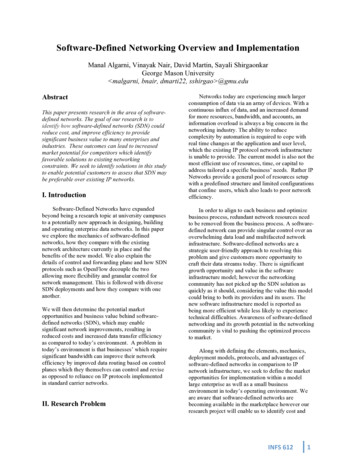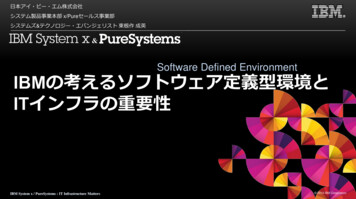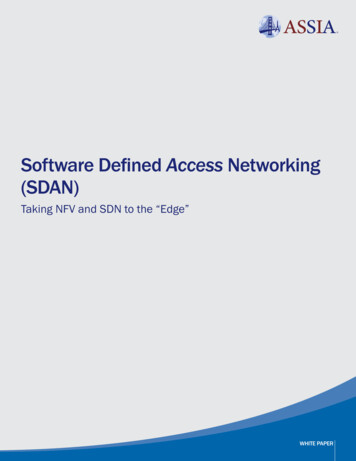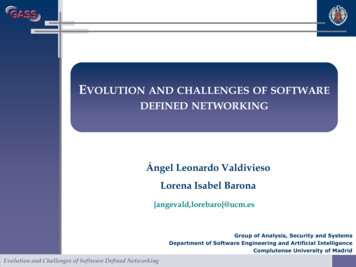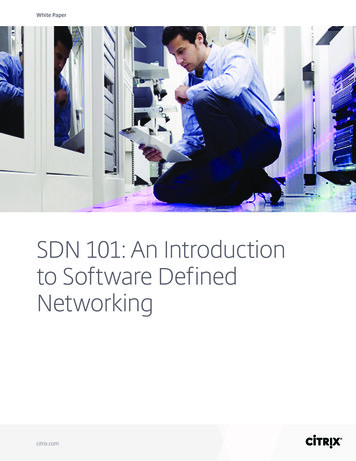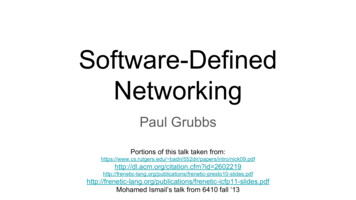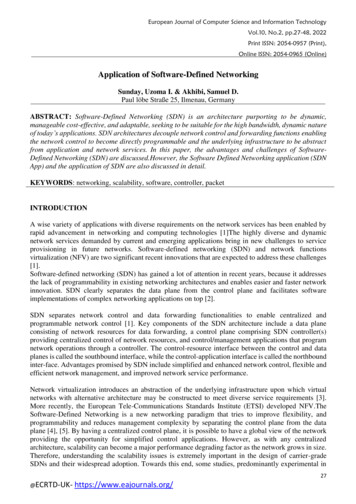
Transcription
European Journal of Computer Science and Information TechnologyVol.10, No.2, pp.27-48, 2022Print ISSN: 2054-0957 (Print),Online ISSN: 2054-0965 (Online)Application of Software-Defined NetworkingSunday, Uzoma I. & Akhibi, Samuel D.Paul löbe Straße 25, Ilmenau, GermanyABSTRACT: Software-Defined Networking (SDN) is an architecture purporting to be dynamic,manageable cost-effective, and adaptable, seeking to be suitable for the high bandwidth, dynamic natureof today’s applications. SDN architectures decouple network control and forwarding functions enablingthe network control to become directly programmable and the underlying infrastructure to be abstractfrom application and network services. In this paper, the advantages and challenges of SoftwareDefined Networking (SDN) are discussed.However, the Software Defined Networking application (SDNApp) and the application of SDN are also discussed in detail.KEYWORDS: networking, scalability, software, controller, packetINTRODUCTIONA wise variety of applications with diverse requirements on the network services has been enabled byrapid advancement in networking and computing technologies [1]The highly diverse and dynamicnetwork services demanded by current and emerging applications bring in new challenges to serviceprovisioning in future networks. Software-defined networking (SDN) and network functionsvirtualization (NFV) are two significant recent innovations that are expected to address these challenges[1].Software-defined networking (SDN) has gained a lot of attention in recent years, because it addressesthe lack of programmability in existing networking architectures and enables easier and faster networkinnovation. SDN clearly separates the data plane from the control plane and facilitates softwareimplementations of complex networking applications on top [2].SDN separates network control and data forwarding functionalities to enable centralized andprogrammable network control [1]. Key components of the SDN architecture include a data planeconsisting of network resources for data forwarding, a control plane comprising SDN controller(s)providing centralized control of network resources, and control/management applications that programnetwork operations through a controller. The control-resource interface between the control and dataplanes is called the southbound interface, while the control-application interface is called the northboundinter-face. Advantages promised by SDN include simplified and enhanced network control, flexible andefficient network management, and improved network service performance.Network virtualization introduces an abstraction of the underlying infrastructure upon which virtualnetworks with alternative architecture may be constructed to meet diverse service requirements [3].More recently, the European Tele-Communications Standards Institute (ETSI) developed NFV.TheSoftware-Defined Networking is a new networking paradigm that tries to improve flexibility, andprogrammability and reduces management complexity by separating the control plane from the dataplane [4], [5]. By having a centralized control plane, it is possible to have a global view of the networkproviding the opportunity for simplified control applications. However, as with any centralizedarchitecture, scalability can become a major performance degrading factor as the network grows in size.Therefore, understanding the scalability issues is extremely important in the design of carrier-gradeSDNs and their widespread adoption. Towards this end, some studies, predominantly experimental in27@ECRTD-UK-https://www.eajournals.org/
European Journal of Computer Science and Information TechnologyVol.10, No.2, pp.27-48, 2022Print ISSN: 2054-0957 (Print),Online ISSN: 2054-0965 (Online)nature, have been carried out. Yeganeh et al. [3] points out several scalability concerns and argue thatthey are not specific to SDNs. In [4], the authors evaluated the first SDN controller, NOX, and reportedthat it can only serve 30,000 flow initiation requests while maintaining the flow setup time of less than10 msec. The scalability of different control plane architectures (centralized, de-centralized andhierarchical) is compared using simple queuing models in [5]. Solutions ranging from a distributedcontroller architecture [6] to moving some control functions back to the switches [7] are proposed toalleviate the scalability issues.In the context of SDNs, scalability has always been evaluated based on the number of flow initiationrequests that can be supported while guaranteeing a Quality of Service (QoS) factor such as the flowsetup time1. While the above metric for scalability is important, it is more appropriate for static networksand does not capture issues that surface when the network topology changes frequently.Characterizing the throughput loss due to topology changes is hard without detailed information aboutthe topology. However, we can use, as a first approximation, the level of inconsistency between thecontroller’s view of the topology and the actual network as a proxy for the throughput degradation [10].Note that having a link in the actual network, but not in the controller’s view of the topology, is not anissue because the flow table will not have that additional link [11]. However, the inconsistency causedby a link failure could lead to throughput degradation if that link is present in the path of an alreadyestablished flow. It is straight-forward to compute the expected flow setup time when the size of anetwork in terms of the number of switches and links is known. In this paper, we define scalability asthe number of switches that can be controlled while maintaining the inconsistency below a certainnumber of links and maintaining the expected flow setup time below a certain threshold when the linksare characterized by the distributions of their lifetimes and down-times [10].REVIEW OF RELEVANT LITERATUREThe past few years have witnessed exciting progress in SDN technologies and their applications invarious networking scenarios [12], including wireless networks [14]. On the other hand, researchershave noticed some issues of the current SDN approach that may limit its ability to fully support futurenetwork services [15, 16]. To meet the evolving diverse service requirements, SDN data plane devicesneed to fully perform general flow matching and packet forwarding, which may significantly increasecomplexity and cost of SDN switches. On the control plane, current SDN architecture lacks sufficientsupport of interoperability among heterogeneous SDN controllers, and thus limits its ability to provisionflexible end-to-end services across autonomous domains.A root reason for the limitation of current SDN design to achieve its full potential for serviceprovisioning is the tight coupling between network architecture and infrastructure on both data andcontrol planes. Separation between data and control planes alone in the current SDN architecture is notsufficient to overcome this obstacle. Another dimension of abstraction to decouple service functions andnetwork infra-structures is needed in order to unlock SDN’s full potential. Therefore, applying theinsights of NFV in SDN may further enhance the latter’s capability of flexible service provisioning.On the other hand, many technical challenges must be addressed for realizing the NFV paradigm.Management and orchestration have been identified as key components in the ETSI NFV architecture.Much more sophisticated control and management mechanisms for both virtual and physical resourcesare required by the highly dynamic networking environment enabled by NFV, in which programmaticnetwork control is indispensable. Employing the SDN principle — decoupling control intelligence from28@ECRTD-UK-https://www.eajournals.org/
European Journal of Computer Science and Information TechnologyVol.10, No.2, pp.27-48, 2022Print ISSN: 2054-0957 (Print),Online ISSN: 2054-0965 (Online)the controlled resources to enable a logically centralized programmable control/management plane —in the NFV architecture may greatly facilitate realization of NFV [17].Recent research efforts toward combining SDN and NFV to enhance network service provisioning havebeen made from various aspects. Hypervisor and container-based virtualization mechanisms have beenapplied to support multi-tenant virtual SDN networks. For example, the network hypervisor Flow-Visor[18] allows multiple controllers to share an Open Flow platform and slice data plane infrastructure.FlowN [18] offers container-based virtualization solution in which each tenant may run its own controlapplication on a shared SDN controller. Some network system designs have explored utilizingcapabilities of both SDN and NFV. For example, Woods et al. [19] presented NetVM, a highperformance virtual server platform for supporting NFV, and discussed design guidelines for combiningSDN controllers with NetVM to provide coordinated network management. Ding et al. [10] designed anopen platform for service chain as a service by using capabilities of SDN together with NFV. Theprogressive evolution from SDN-agnostic NFV initiative to SDN-enabled NFV solution was discussedin [11]. Relevant standardization organizations are also actively conducting the related study. The OpenNetwork Foundation (ONF) recently released a report on the relationship of SDN and NFV [20], andETSI NFV ISG is currentlyFigure 1.2 A two-dimensional model of layer-plane abstraction in future networking.Recent research efforts toward combining SDN and NFV to enhance network service provisioning havebeen made from various aspects. Hypervisor and container-based virtualization mechanisms have beenapplied to support multi-tenant virtual SDN networks. For example, the network hypervisor Flow-Visor[17] allows multiple controllers to share an OpenFlow platform and slice data plane infrastructure.FlowN [18] offers a container-based virtualization solution in which each tenant may run its own controlapplication on a shared SDN controller. Some network system designs have explored utilizingcapabilities of both SDN and NFV. For example, Woods et al. [19] presented NetVM, a highperformance virtual server platform for supporting NFV, and discussed design guidelines for combiningSDN controllers with NetVM to provide coordinated network management. Ding et al. [20] designed anopen platform for service chain as a service by using capabilities of SDN together with NFV. Theprogressive evolution from SDN-agnostic NFV initiative to SDN-enabled NFV solution was discussedin [21]. Relevant standardization organizations are also actively conducting the related study. The Open29@ECRTD-UK-https://www.eajournals.org/
European Journal of Computer Science and Information TechnologyVol.10, No.2, pp.27-48, 2022Print ISSN: 2054-0957 (Print),Online ISSN: 2054-0965 (Online)Network Foundation (ONF) recently released a report on the relationship of SDN and NFV [12], andETSI NFV ISG is currently working on a draft report regarding SDN usage in the NFV architecture [23].Although encouraging progress has been made toward combining SDN and NFV, research in this areais still in its infant stage. Current works address the problem from various aspects, including hypervisorsfor virtual SDN networks, usage of SDN controllers in NFV architecture, and SDN/NFV hybridsolutions for service provisioning. It is desirable to have a high-level framework that provides a holisticvision of how SDN and NFV principles may naturally fit into unified network architecture, which maygreatly facilitate the research and technical development in this area. This motivates the work presentedin the rest of this article.A Two-Dimensional Abstraction Model for SDN and NFV Integration In this section, we present a twodimensional abstraction model to show how SDN and NFV principles are related to each other and howthey may fit in unified network architecture.As shown in Fig. 1.2, this abstraction model has layers as well as planes with clear distinction betweenthese two concepts. Both layers and planes offer abstraction in network architecture but in differentdimensions. Abstraction provided by layers is in the vertical dimension in the model, starting withunderlying hardware and then adding a sequence of layers, each providing a higher (more abstract) levelof service. A key property of layering is that the functions of a higher layer rely on the services providedby the lower layers, therefore forming a stack of layers for offering services to applications on the top.On the other hand, plane abstraction is in the horizontal dimension in that functions performed on aplane do not necessarily rely on functions of another plane; therefore, there is no higher or lower plane.Instead, each plane focuses on a particular aspect of the entire network system, such as data transport,network control, and system management. Each plane may comprise multiple layers from physicalhardware to application software and collaborates with other planes for network service provisioning.Traditional circuit-switching-based telecommunication systems embraced plane-dimension abstraction(separating data, control, and management planes) without clear abstraction on the layer dimension. Forexample, Signal System No. 7 was logically separated from voice channels, and the intelligent network(IN) had service control points (SCPs) decoupled from the data transportation platform [24].PROTOCOL OPTIONS FOR THE SOUTHBOUND INTERFACEThe most common southbound interface is Open Flow, which is standardized by the Open NetworkingFoundation (ONF). Open Flow is a protocol that describes the interaction of one or more control serverswith Open Flow-compliant switches. An Open Flow controller installs flow table entries in switches, sothat these switches can forward traffic according to these entries. Thus, Open Flow switches depend onconfiguration by controllers. A flow is classified by match fields that are similar to access control lists(ACLs) and may contain wildcards. In Section 3, we provide a detailed description of Open Flow anddescribe the features offered by different versions of the protocol.Another option for the southbound interface is the Forwarding and Control Element Separation(ForCES) [5,6] which is discussed and has been standardized by the Internet Engineering Task Force(IETF) since 2004. ForCES is also a framework, not only a protocol; the ForCES framework alsoseparates the control plane and data plane, but is considered more flexible and more powerful thanOpenFlow [7,8]. Forwarding devices are modeled using logical function blocks (LFB) that can becomposed in a modular way to form complex forwarding mechanisms. Each LFB provides a given30@ECRTD-UK-https://www.eajournals.org/
European Journal of Computer Science and Information TechnologyVol.10, No.2, pp.27-48, 2022Print ISSN: 2054-0957 (Print),Online ISSN: 2054-0965 (Online)functionality, such as IP routing. The LFBs model a forwarding device and cooperate to form even morecomplex network devices. Control elements use the ForCES protocol to configure the interconnectedLFBs to modify the behavior of the forwarding elements.The Soft Router architecture [9] also defines separate control and data plane functionality. It allowsdynamic bindings between control elements and data plane elements, which allows a dynamicassignment of control and data plane elements. In [9], the authors present the SoftRouter architectureand highlight its advantages on the Border Gateway Protocol (BGP) with regard to reliability.ForCES and Soft Router have similarities with OpenFlow and can fulfill the role of the southboundinterface. Other networking technologies are also discussed, as well as possible southbound interfacesin the IETF. For instance, the Path Computation Element (PCE) [10] and the Locator/ID SeparationProtocol (LISP) [11] are candidates for southbound interfaces.NORTHBOUND APIS FOR NETWORK APPLICATIONSAs we will highlight in Section 3, the OpenFlow protocol provides an interface that allows a controlsoftware to program switches in the network. Basically, the controller can change the forwardingbehavior of a switch by altering the forwarding table. Controllers often provide a similar interface toapplications, which is called the northbound interface, to expose the programmability of the network.The northbound interface is not standardized and often allows fine-grained control of the switches.Applications should not have to deal with the details of the southbound interface, e.g., the applicationdoes not need to know all details about the network topology, etc. For instance, a traffic engineeringnetwork applications should tell the controller the path layout of the flows, but the controller shouldcreate appropriate commands to modify the forwarding tables of the switches. Thus, networkprogramming languages are needed to ease and automate the configuration and management of thenetwork.The requirements of a language for SDN are discussed in [12]. The authors focus on three importantaspects. (1) The network programming language has to provide the means for querying the networkstate. The language runtime environment gathers the network state and statistics, which is then providedto the application; (2) The language must be able to express network policies that define the packetforwarding behavior. It should be possible to combine policies of different network applications.Network applications possibly construct conflicting network policies, and the network language shouldbe powerful enough to express and to resolve such conflicts; (3) The reconfiguration of the network is adifficult task, especially with various network policies. The runtime environment has to trigger theupdate process of the devices to guarantee that access control is preserved, forwarding loops are avoidedor other invariants are met.Popular SDN programming languages that fulfill the presented requirements are Frenetic [13], itssuccessor, Pyretic [14], and Procera [15]. These languages provide a declarative syntax and are basedon functional reactive programming. Due to the nature of functional reactive programming, theselanguages provide a composable interface for network policies. Various other proposals exist, as well.The European FP7 research project, NetIDE, addresses the northbound interfaces of SDN networks[16].SDN, ACTIVE AND PROGRAMMABLE NETWORKSIn the past, various technologies were developed to enable programmability in communication networks.Active networks (AN) [17] were developed in the 1990s. The basic idea of active networks is to inject31@ECRTD-UK-https://www.eajournals.org/
European Journal of Computer Science and Information TechnologyVol.10, No.2, pp.27-48, 2022Print ISSN: 2054-0957 (Print),Online ISSN: 2054-0965 (Online)programs into data packets. Switches extract and execute programs from data packets. With this method,new routing mechanisms and network services can be implemented without the modification of theforwarding hardware. However, this approach has not prevailed, due to security concerns andperformance issues that can occur on executing programs in the forwarding devices. For example, anattacker can inject malicious programs into network packets and forward them into the network.Programmable networks (PN) [18,19] also provide a means for programmability in the network byexecuting programs on packets similar to AN. However, programs are not included in the data packetsas with AN. The programs are installed inside the network nodes, which execute the programs on thepackets. This clearly reduced security concerns that occur with AN, because a network node only acceptsprograms after a prior signaling and node setup. Various proposals for PN were made in the past. Forexample, xbind [20] was proposed for asynchronous transfer mode (ATM) networks that are tailoredtowards quality of service (QoS) and multimedia applications. The aim of xbind was to overcome thecomplexity associated with ATM and to allow easier service creation by separating the controlalgorithms from the ATM protocol, which was enabled by the programmability of the forwardingdevices through programming languages.Both approaches, AN and PN, introduce new flexibility by allowing programs to be executed within thenetwork. They are more flexible than an OpenFlow-based SDN approach, because they allow one toprogram the data plane in an extensible way. New data plane functionality can be implemented throughprograms that are either part of data packets with AN or installed inside network nodes with PN. AnOpenFlow-based SDN approach cannot extend the data plane functionality without an upgrade of theswitches, due to the fact that OpenFlow only provides a fixed set of network operations. The OpenFlowcontroller is only able to program the switch with its supported set of operations.SYSTEM DESCRIPTIONIn traditional IP networks, the packet routers are in charge of determining the routing policies and othercontrol functions as well as forwarding the packets. That is, the control plane and data plane are tightlycoupled in traditional networking architectures. The key idea behind SDNs is to separate the controlplane, managed by a controller, from the data plane consisting of a set of forwarding elements orswitches. The basic SDN architecture that separates control plane from data plane is shown in Fig. 1.6.In the figure, the services provided by the network operator, such as security, are termed as theapplication, and they communicate with the SDN controller using interfaces called northbound APIs[80] (for e.g., Procera and RESTFul [70]). The SDN controller controls and programs the switches toperform different functionality using APIs that are termed as southbound APIs (the most commoninterfaces are OpenFlow [9], ForCES, and NetConf [2]).We start by describing the flow setup process in SDNs. A more detailed description can be found in[10]. As a part of the start-up procedure, an SDN switch will communicate its IP address and all itsavailable switch ports to the controller. When a packet from a new flow arrives, the switch first checksif there is an entry in its flow table corresponding to the packet it received. If there is no forwarding ruleavailable in the flow table for the received packet, then the packet is forwarded to the controller (forexample, in OpenFlow the packet is encapsulated in a Packet In message). The controller, uponreceiving the message from the switch, computes or fetches the pre-computed forwarding rules andinstalls them in all the concerned switches along the path of the flow. Once the forwarding rules areinstalled in the switches, the switches can forward packets without any intervention from the controller.The controller should have an up-to-date view of the network in order to compute and install appropriatecontrol functions in the switches. If the controller’s view of the network is not consistent with the actual32@ECRTD-UK-https://www.eajournals.org/
European Journal of Computer Science and Information TechnologyVol.10, No.2, pp.27-48, 2022Print ISSN: 2054-0957 (Print),Online ISSN: 2054-0965 (Online)topology, the forwarding rules installed by the controller could be incorrect and could lead to packetdrops causing significant performance degradation. Therefore, the controller performs the topologydiscovery process periodically to update its view of the network.Fig. 1.6. Architecture of a software defined network.THE OPENFLOW PROTOCOLThe OpenFlow protocol is the most commonly used protocol for the southbound interface of SDN, whichseparates the data plane from the control plane. The white paper about OpenFlow [71] points out theadvantages of a flexibly configurable forwarding plane. OpenFlow was initially proposed by StanfordUniversity, and it is now standardized by the ONF [4]. In the following, we first give an overview of thestructure of OpenFlow and then describe the features supported by the different specifications.OverviewThe OpenFlow architecture consists of three basic concepts. (110) The network is built up by OpenFlowcompliant switches that compose the data plane; (102) the control plane consists of one or moreOpenFlow controllers; (3) a secure control channel connects the switches with the control plane. In thefollowing, we discuss OpenFlow switches and controllers and the interactions among them.An OpenFlow-compliant switch is a basic forwarding device that forwards packets according to its flowtable. This table holds a set of flow table entries, each of which consists of match fields, counters andinstructions, as illustrated in Figure 2. Flow table entries are also called flow rules or flow entries. The“header fields” in a flow table entry describe to which packets this entry is applicable. They consist of awildcard-capable match over specified header fields of packets. To allow fast packet forwarding withOpenFlow, the switch requires ternary content addressable memory (TCAM) that allows the fast lookupof wildcard matches. The header fields can match different protocols depending on the OpenFlow.specification, e.g., Ethernet, IPv4, IPv6 or MPLS. The “counters” are reserved for collecting statisticsabout flows. They store the number of received packets and bytes, as well as the duration of the flow.The “actions” specify how packets of that flow are handled. Common actions are “forward”, “drop”,“modify field”, etc.33@ECRTD-UK-https://www.eajournals.org/
European Journal of Computer Science and Information TechnologyVol.10, No.2, pp.27-48, 2022Print ISSN: 2054-0957 (Print),Online ISSN: 2054-0965 (Online)Header Fields CountersActionFigure 1.7.1. Flow table entry for OpenFlow 1.0.A software program, called the controller, is responsible for populating and manipulating the flow tablesof the switches. By insertion, modification and removal of flow entries, the controller can modify thebehavior of the switches with regard to forwarding. The OpenFlow specification defines the protocolthat enables the controller to instruct the switches. To that end, the controller uses a secure controlchannel.Three classes of communication exist in the OpenFlow protocol: controller-to-switch, asynchronous andsymmetric communication (90). The controller-to-switch communication is responsible for featuredetection, configuration, programming the switch and information retrieval. Asynchronouscommunication is initiated by the OpenFlow-compliant switch without any solicitation from thecontroller. It is used to inform the controller about packet arrivals, state changes at the switch and errors.Finally, symmetric messages are sent without solicitation from either side, i.e., the switch or thecontrollers are free to initiate the communication without solicitation from the other side. Examples forsymmetric communication are hello or echo messages that can be used to identify whether the controlchannel is still live and available (115).Figure 1.7.2. Basic packet forwarding with OpenFlow in a switch.The basic packet forwarding mechanism with OpenFlow is illustrated in Figure 1.7.2. When a switchreceives a packet, it parses the packet header, which is matched against the flow table. If a flow tableentry is found where the header field wildcard matches the header, the entry is considered. If severalsuch entries are found, packets are matched based on prioritization, i.e., the most specific entry or thewildcard with the highest priority is selected. Then, the switch updates the counters of that flow tableentry. Finally, the switch performs the actions specified by the flow table entry on the packet, e.g., theswitch forwards the packet to a port. Otherwise, if no flow table entry matches the packet header, theswitch generally notifies its controller about the packet, which is buffered when the switch is capable ofbuffering. To that end, it encapsulates either the unbuffered packet or the first bytes of the bufferedpacket using a PACKET-IN message and sends it to the controller; it is common to encapsulate thepacket header and the number of bytes defaults to 128. The controller that receives the PACKET-INnotification identifies the correct action for the packet and installs one or more appropriate entries in therequesting switch. Buffered packets are then forwarded according to the rules; this is triggered by settingthe buffer ID in the flow insertion message or in explicit PACKET-OUT messages. Most commonly,the controller sets up the whole path for the packet in the network by modifying the flow tables of allswitches on the path (96).34@ECRTD-UK-https://www.eajournals.org/
European Journal of Computer Science and Information TechnologyVol.10, No.2, pp.27-48, 2022Print ISSN: 2054-0957 (Print),Online ISSN: 2054-0965 (Online)OpenFlow SpecificationsWe now review the different OpenFlow specifications by highlighting the supported operations and thechanges compared to their previous major version and summarize the features of the different versions.Finally, we briefly describe the OpenFlow Configuration and Management Protocol OF-CONFIGprotocol, which adds configuration and management support to OpenFlow switches (84).OpenFlow 1.0The OpenFlow 1.0 specification [22] was released in December, 2009. As of this writing, it is the mostcommonly deployed version of OpenFlow. Ethernet and IP packets can be matched based on the sourceand destination address. In addition, Ethernet-type and VLAN fields can be matched for Ethernet, thedifferentiated services (DS) and Explicit Congestion Notification (ECN) fields, and the protocol fieldcan be matched for IP. Moreover, matching on TCP or UDP source and destination port numbers ispossible.Figure 1.7.2 illustrates the packet handling mechanism of OpenFlow 1.0. The OpenFlow standardexactly specifies the packet parsing and matching algorithm. The packet matching algorithm starts witha comparison of the Ethernet and VLAN fields and continues if necessary with
Application of Software-Defined Networking Sunday, Uzoma I. & Akhibi, Samuel D. Paul löbe Straße 25, Ilmenau, Germany ABSTRACT: Software-Defined Networking (SDN) is an architecture purporting to be dynamic, manageable cost-effective, and adaptable, seeking to be suitable for the high bandwidth, dynamic nature of today's applications.
